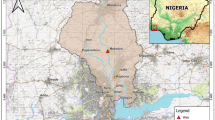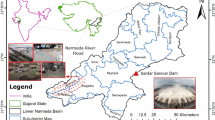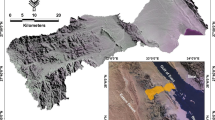Abstract
Climate change increases both the risks and effects of flooding in urban areas, which, without mitigation, may lead to social catastrophes. In Korea, devastating typhoons and overflows account for approximately 90% of the country’s natural disasters, and the many man-made features of urban environments exacerbate the detrimental effects whenever flooding occurs. Many regression analysis methods exist for assessing geographical flood risk; furthermore, a handful of machine learning methods have been created for mitigation and estimation purposes—there are none for prevention. Therefore, in this study, we developed a machine learning flood assessment model that leverages several machine learning models for the Busan Metropolitan City. Each was applied to a test dataset, and their performances were evaluated based on accuracy, sensitivity, specificity, and area under the curve; thereafter, the model determined to be the most reliable was used to create a flood risk assessment map. The model was then used to assess the areas of highest probability of flooding. Upon its completion, we discovered that flooding may now occur with less rainfall than that of the 10-year return period. The derived map is expected to be used as a basic source for the development of preventive countermeasures against urban flooding, thus contributing to the enhancement of flood control and response capacities in applicable regions.









Similar content being viewed by others
References
Ahmad N, Hussain M, Riaz N, Subhani F, Haider S, Alamgir KS, Shinwari F (2013) Flood prediction and disaster risk analysis using GIS based wireless sensor networks, a review. J Basic Appl Sci Res 3(8):632–643
Alexander D (1993) Natural disasters. UCL Press, London
Birkmann J (2006) Measuring vulnerability to natural hazards: towards disaster resilient societies. United Nations University Press, Tokyo
Breiman L (1996) Out-of-bag estimation. Technical Report, Statistics Department, University of California Berkeley, Berkeley, California 94708, https://www.stat.berkeley.edu/~breiman/OOBestimation.pdf.
Breiman L, Ihaka R (1984) Nonlinear discriminant analysis via scaling and ACE. Department of Statistics, University of California
Büchele B, Kreibich H, Kron A, Thieken A, Ihringer J, Oberle P, Nestmann F (2006) Flood-risk mapping: contributions towards an enhanced assessment of extreme events and associated risks. Nat Hazard 6(4):485–503
Bui DT, Pradhan B, Nampak H, Bui QT, Tran QA, Nguyen QP (2016) Hybrid artificial intelligence approach based on neural fuzzy inference model and metaheuristic optimization for flood susceptibility modeling in a high-frequency tropical cyclone area using GIS. J Hydrol 540:317–330
Cançado VL, Brasil LS, Guerra A, Nascimento NDO (2008) Análise de vulnerabilidade à inundação: estudo de caso da cidade de Manhuaçu, Minas Gerais. XVII Simpósio Brasileiro de Recursos Hídricos 3:1–16
Carlos E, Tucci, M (2007) Urban Flood Management. Hydraulic Research Institute, Federal University of Rio Grande, Rio Grande
Chapi K, Singh VP, Shirzadi A, Shahabi H, Bui DT, Pham BT, Khosravi K (2017) A novel hybrid artificial intelligence approach for flood susceptibility assessment. Environ Model Softw 95:229–245
Chen W, Li Y, Xue W et al (2020) Modeling flood susceptibility using data-driven approaches of naïve bayes tree, alternating decision tree, and random forest methods. Sci Total Environ 701:134979
Chen YR, Yeh CH, Yu B (2011) Integrated application of the analytic hierarchy process and the geographic information system for flood risk assessment and flood plain management in Taiwan. Nat Hazards 59(3):1261–1276
Choi CH, Kim JS, Kim DH, Lee JH, Kim DK, Kim HS (2018) Development of heavy rain damage prediction functions in the seoul capital Area using machine learning techniques. J Korean Soc Hazard Mitig 18:435–447
Choi HS, Park HW, Park CY (2013) Support vector machines for big data analysis. J Korean Data Inf Sci Soc 24(5):989–998
Dutta D, Herath S (2001) GIS based flood loss estimation modeling in Japan. In: Proceedings of the US-Japan 1st workshop on comparative study on urban disaster management, pp 151–161
Falconer RH, Cobby D, Smyth P, Astle G, Dent J, Golding B (2009) Pluvial flooding: new approaches in flood warning, mapping and risk management. J Flood Risk Manag 2(3):198–208
Golding BW (2009) Long lead time flood warnings: reality or fantasy? Meteorol Appl 16:3–12
Han WS, Park TS (2014) Diagnosis of problems in the urban flood disaster prevention system and policy direction. KRIHS POLICY BRIEF 470:1–6
Herath S, Musiake K, Hironaka S (2003) A simulation study of infiltration facility impact on the water cycle of an urban catchment. Int Assoc Hydrol Sci 281:294–302
Hong H, Tsangaratos P, Ilia I, Liu J, Zhu AX, Chen W (2018) Application of fuzzy weight of evidence and data mining techniques in construction of flood susceptibility map of Poyang County, China. Sci Total Environ 625:575–588
Jang DW, Kim BS, Yang DM, Kim BK, Seoh BH (2009) A development of GIS based excess flood protection system-using decision support methods. Korean Soc Civil Eng 2:630–634
Jenks GF (1967) The data model concept in statistical mapping. Int Yearbook Cartogr 7:186–190
Kang JE, Lee MJ (2012) Assessment of flood vulnerability to climate change using fuzzy model and GIS in Seoul. J Korean Assoc Geogr Inf Stud 15(3):119–136
Kang JE, Lee MJ (2015) Analysis of urban infrastructure risk areas to flooding using neural network in Seoul. J Korean Soc Civil Eng 35(4):997–1006
Kelman I, Spence R (2004) An overview of flood actions on buildings. Eng Geol 73(3–4):297–309
Khosravi K, Nohani E, Maroufinia E, Pourghasemi HR (2016) A GIS-based flood susceptibility assessment and its mapping in Iran: a comparison between frequency ratio and weights-of-evidence bivariate statistical models with multi-criteria decision-making technique. Nat Hazards 83(2):947–987
Khosravi K, Shahabi H, Pham BT et al (2019) A comparative assessment of flood susceptibility modeling using multi-criteria decision-making analysis and machine learning methods. J Hydrol 573:311–323
Kia MB, Pirasteh S, Pradhan B, Mahmud AR, Sulaiman WNA, Moradi A (2012) An artificial neural network model for flood simulation using GIS: Johor River Basin. Malay Environ Earth Sci 67(1):251–264
Kim DH, Kim JM, Yoon BC, Chang EM, Choi YS (2015) Development plan of grid system utilizing spatial information. J Korea Spat Inf Soc 23(6):43–55
Kim MJ, Kim GS (2018) Analysis of flood damage type by climate change using stepwise regression model. In: Proceedings of the korea water resources association conference. Korea Water Resources Association, pp 394
Korea Meteorological Administration (2017) Busan Metropolitan City Climate Change Assessment Report.
Lee HH, Chung SH, Choi EJ (2016a) A case study on machine learning applications and performance improvement in learning algorithm. J Digit Converg 14(2):245–258
Lee SE, Kim CH, Park TS, Kim ME, Kim SY, Lee TS, Kim JH (2016) Development of the Urban Flooding Risk Prevention System (I). Korea Research Institute for Human Settlements
Lee SE, Kim JW, Han WS et al. (2018) Development of the Urban Flooding Risk Prevention System (III). Korea Research Institute for Human Settlements
Lee SE, Kim SH (2015) New water resource technology paradigm in the era of water welfare, securing water, securing diversity in water use and reducing water disasters. Water Futur 48(1):68–75
Lee SH, Kang JE (2018) Urban flood vulnerability and risk assessments for applying to urban planning. J Korea Plan Assoc 53(5):185–206
Lee SH, Kang JE, Park CS (2016c) Urban flood risk assessment considering climate change using bayesian probability statistics and GIS: a case study from Seocho-Gu, Seoul. J Korean Assoc Geogr Inf Stud 19(4):36–51
Lee SM (2017) Spatial Analysis of Flood and Landslide Susceptibility in Seoul using Random Forest and Boosted Tree Models. Dissertation, University of Seoul
Lee SS, Park GW, Jang SM, An BJ, Ha SM (2019) Change from scenario-based to real-time prediction for proactive urban flood response. Mag Korean Soc Agric Eng 61(3):38–43
Liaw A, Wiener M (2002) Classification and regression by randomForest. R News 2(3):18–22
Lim KS, Kang SW, Hwang MH, Choi SJ (2010) Development of evaluation system for optimal flood protection plan. In: Proceedings of the Korea water resources association conference, Korea Water Resources Association, pp 822–826
Liu R, Chen Y, Wu J et al (2016) Assessing spatial likelihood of flooding hazard using naïve Bayes and GIS: a case study in Bowen Basin, Australia. Stoch Env Res Risk Assess 30(6):1575–1590
Marconi M, Gatto B, Magni M, Marincioni F (2016) A rapid method for flood susceptibility mapping in two districts of Phatthalung Province (Thailand): present and projected conditions for 2050. Nat Hazards 81(1):329–346
Nicholas J, Holt GD, Proverbs DG (2001) Towards standardising the assessment of flood damaged properties in the UK. Struct Surv 19(4):163–172
Ouma YO, Tateishi R (2014) Urban flood vulnerability and risk mapping using integrated multi-parametric AHP and GIS: methodological overview and case study assessment. Water 6(6):1515–1545
Park MJ, Jun HD, Shin MC (2007) Estimation of sediments in urban watersheds and relation analysis between sediments and inundation risk using GIS. J Korean Soc Civil Eng B 27(3B):277–287
Penning-Rowsell E (1999) Flood hazard assessment, modelling and management: results from the EUROflood project. Environments 27(1):79
Rahmati O, Pourghasemi HR (2017) Identification of critical flood prone areas in data-scarce and ungauged regions: a comparison of three data mining models. Water Resour Manag 31(5):1473–1487
Seekao C, Pharino C (2016) Assessment of the flood vulnerability of shrimp farms using a multicriteria evaluation and GIS: a case study in the Bangpakong Sub-Basin. Thailand Environ Earth Sci 75(4):308
Seo MW, Lee JS, Choi Y (2016) Estimation of the natural damage disaster considering the spatial autocorrelation and urban characteristics. J Korean Soc Civil Eng 36(4):723–733
Shon TS, Kang DH, Jang JK, Shin HS (2010) A study of assessment for internal inundation vulnerability in urban area using SWMM. J Korean Soc Hazard Mitig 10(4):105–117
Sim UB (2008) Characteristics of urban flood damage in Korea and response tasks. Water Future 41(9):41–46
Sim UB (2011) New paradigm and urban policy for urban prevention of natural disasters preparing to climate change. Issue Paper 29:1–58
Smith DI (1994) Flood damage estimation-a review of urban stage-damage curves and loss functions. Water Sea 20(3):231–238
Son MS, Park JY, Kim HS (2013) Urban environmental risk -evaluating flooding risk indices of Seoul. Seoul Stud 14(4):127–140
Son MW, Sung JY, Chung ES, Jun KS (2011) Development of flood vulnerability index considering climate change. J Korea Water Resour Assoc 44(3):231–248
Song YS (2012) Quantitative relationship between flood vulnerability and urban inundation characteristics. Dissertation, University of Hanseo
Tang Z, Zhang H, Yi S et al (2018) Assessment of flood susceptible areas using spatially explicit, probabilistic multi-criteria decision analysis. J Hydrol 558:144–158
Tehrany MS, Pradhan B, Jebur MN (2013) Spatial prediction of flood susceptible areas using rule based decision tree (DT) and a novel ensemble bivariate and multivariate statistical models in GIS. J Hydrol 504:69–79
Tehrany MS, Pradhan B, Jebur MN (2014) Flood susceptibility mapping using a novel ensemble weights-of-evidence and support vector machine models in GIS. J Hydrol 512:332–343
Tehrany MS, Pradhan B, Mansor S et al (2015) Flood susceptibility assessment using GIS-based support vector machine model with different kernel types. CATENA 125:91–101
Tsakiris G (2014) Flood risk assessment: concepts, modelling, applications. Nat Hazard 14(5):1361–1369
US Army Corps of Engineers (USACE) (1996) Risk-based analysis for flood damage reduction studies. Manual, Eng, Washington, D.C.
Vojtek M, Vojteková J (2019) Flood susceptibility mapping on a national scale in Slovakia using the analytical hierarchy process. Water 11(2):364
Youssef AM, Pradhan B, Sefry SA (2016) Flash flood susceptibility assessment in Jeddah city (Kingdom of Saudi Arabia) using bivariate and multivariate statistical models. Environ Earth Sci 75(1):12
Zhao G, Pang B, Xu Z et al (2018) Mapping flood susceptibility in mountainous areas on a national scale in China. Sci Total Environ 615:1133–1142
Acknowledgements
This study was partially supported by Korea Ministry of Land, Infrastructure and Transport (MOLIT), as Innovative Talent Education Program for Smart City.
Author information
Authors and Affiliations
Corresponding author
Additional information
Publisher's Note
Springer Nature remains neutral with regard to jurisdictional claims in published maps and institutional affiliations.
Rights and permissions
About this article
Cite this article
Ha, J., Kang, J. Assessment of flood-risk areas using random forest techniques: Busan Metropolitan City. Nat Hazards 111, 2407–2429 (2022). https://doi.org/10.1007/s11069-021-05142-5
Received:
Accepted:
Published:
Issue Date:
DOI: https://doi.org/10.1007/s11069-021-05142-5




